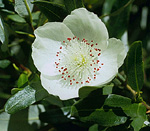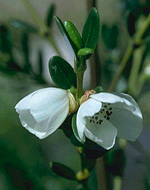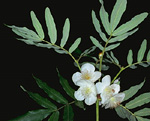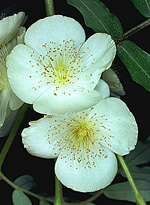 |
This small family comprises a single genus, Eucryphia, found in cool-temperate rain forests of south-eastern Australia and Tasmania, and in comparable sites in Chile.
Characteristic features of the family Eucryphiaceae in Australia include:
- trees (or sometimes shrubby) with simple or pinnate, opposite leaves, the dormant buds, expanding leaves and young stems often covered in resin
- calyx forming a cap which falls when the flower opens
- flowers showy, with 4 large, white, free petals and numerous stamens
- ovary superior; fruit a woody or leathery capsule containing winged seeds
Description
Evergreen trees or shrubs. Stem nodes conspicuously swollen or not. Internal secretions not obvious or of resin. Plants glabrous or with simple, non-glandular, unicellular hairs. Leaves opposite, petiolate; pulvinae present. Stipules present, interpetiolar, scale-like or membranous, falling off early; stipellae absent. Lamina simple or once compound, unifoliolate, ternate or imparipinnate, symmetric, lanceolate, ovate, elliptic, oblanceolate, obovate or oblong; base cuneate, rounded or oblique; margins entire, ±flat, revolute or recurved; venation pinnate, with the midrib conspicuous, and the tertiary venation not reticulate; surfaces not punctate; herbaceous. All the flowers bisexual. Inflorescences axillary, consisting of umbels or solitary flowers. Bracts present. Mucilaginous hairs ?present or absent on buds. Pollination by insects. Flowers fragrant; stalked. Floral disc absent; nectaries present on the stamens. Perianth regular, of 2 dissimilar whorls, imbricate in bud. Calyptra present or apparently absent. Calyx segments free, or apically calyptrate by resin fusion, with 4 sepals or lobes; calyx cup-shaped, herbaceous or papery. Corolla segments free, with 4 petals, with no clear relationship to the sepals or calyx lobes, white or pink, without contrasting markings, membranous; claws absent; lobes ±entire. Fertile stamens numerous, not clearly correlated with the sepals or calyx lobes, free of the corolla, free of the ovary and style, distinct from each other, all ±equal. Anthers dorsifixed, versatile, opening sideways by longitudinal slits, 2-celled. Ovary superior and sessile. Carpels (4–) 5–12 (–18), fused; ovary with (4–) 5–12 (–18) locules. Style terminal, single and branched above or from the base. Ovules 3–20 per locule, sessile; placentation axile. Fruit a dry, dehiscent septicidal capsule; the perianth on the maturing fruit deciduous. Disseminule macro-surface winged; micro-surface ±smooth, brown, dull. Seeds 3–numerous per fruit. Aril absent. Cotyledons 2. Embryo straight.
(Note: this description has been generated from the coded data compiled for the key. Any errors in the key data will be reflected in the descriptions.)
A treatment of the family Eucryphiaceae has not yet been published in the Flora of Australia. It will appear in Volume 10.
Australian genera of Eucryphiaceae (as recognised for the Flora of Australia)
Eucryphia

|
  |

Eucryphia lucida (flower)
Photo: C.Green © ANBG

Eucryphia milliganii (flowers)
Photo: M.Fagg © ANBG

Eucryphia moorei (flowering branch)
Photo: M.Fagg © ANBG

Eucryphia moorei (flowers)
Photo: M.Fagg © ANBG
|
 |
|